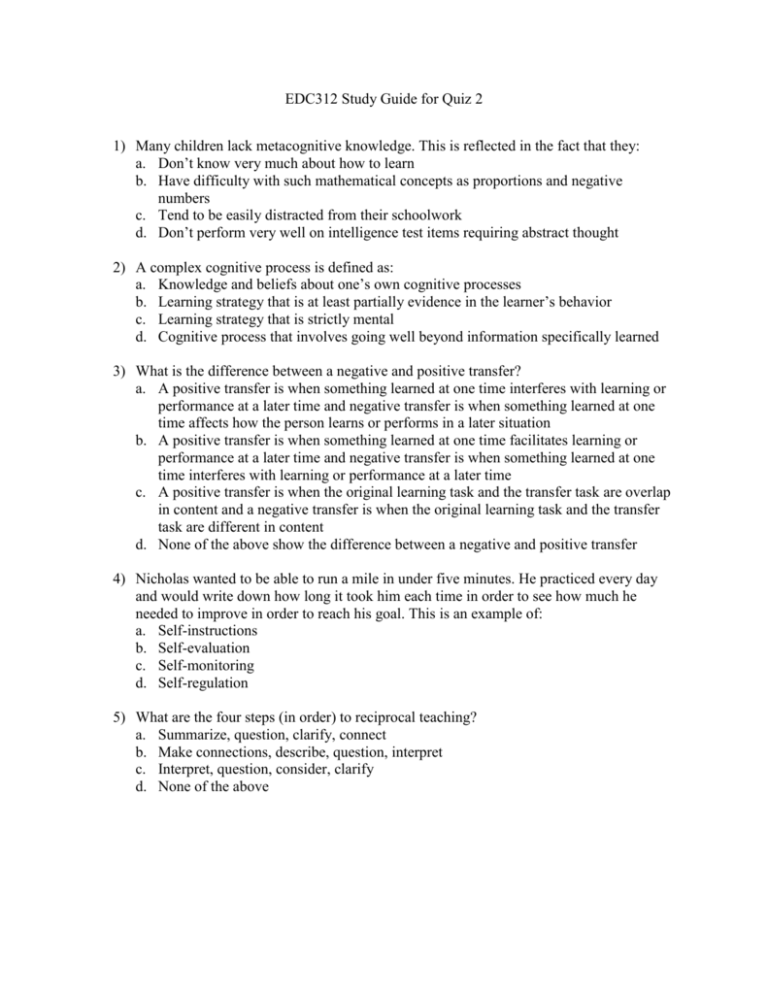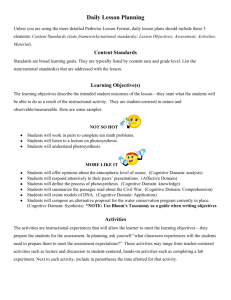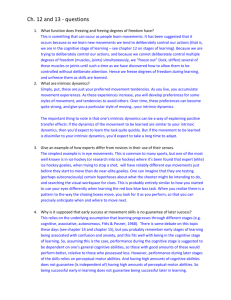EDC312 Study Guide Quiz 2 - URI
advertisement

EDC312 Study Guide for Quiz 2 1) Many children lack metacognitive knowledge. This is reflected in the fact that they: a. Don’t know very much about how to learn b. Have difficulty with such mathematical concepts as proportions and negative numbers c. Tend to be easily distracted from their schoolwork d. Don’t perform very well on intelligence test items requiring abstract thought 2) A complex cognitive process is defined as: a. Knowledge and beliefs about one’s own cognitive processes b. Learning strategy that is at least partially evidence in the learner’s behavior c. Learning strategy that is strictly mental d. Cognitive process that involves going well beyond information specifically learned 3) What is the difference between a negative and positive transfer? a. A positive transfer is when something learned at one time interferes with learning or performance at a later time and negative transfer is when something learned at one time affects how the person learns or performs in a later situation b. A positive transfer is when something learned at one time facilitates learning or performance at a later time and negative transfer is when something learned at one time interferes with learning or performance at a later time c. A positive transfer is when the original learning task and the transfer task are overlap in content and a negative transfer is when the original learning task and the transfer task are different in content d. None of the above show the difference between a negative and positive transfer 4) Nicholas wanted to be able to run a mile in under five minutes. He practiced every day and would write down how long it took him each time in order to see how much he needed to improve in order to reach his goal. This is an example of: a. Self-instructions b. Self-evaluation c. Self-monitoring d. Self-regulation 5) What are the four steps (in order) to reciprocal teaching? a. Summarize, question, clarify, connect b. Make connections, describe, question, interpret c. Interpret, question, consider, clarify d. None of the above 6) Fill in the triangle based on Bloom’s Taxonomy levels of thinking. 7) Describe the six theoretical approaches to development. a. Cognitive-Developmental Theory: _________________________________ _____________________________________________________________ b. Nativism: _____________________________________________________ ______________________________________________________________ c. Sociocultural Theory: ____________________________________________ _______________________________________________________________ d. Information-Processing Theory: _____________________________________ __________________________________________________________________ e. Ecological Systems Theory: _____________________________________ ___________________________________________________________ 8) Which one of the following pairs of children best illustrates a difference in temperament? a. Ann enjoys dancing; Alice prefers basketball b. Bob likes to spend his time reading; Bill would rather watch a good movie c. Carol is very sociable and outgoing; Christ is more quiet and reserved around peers d. Dan likes to think about abstract ideas; David learns more effectively when he can manipulate concrete objects 9) Assimilation is defined as: a. Organized group of similar actions or thoughts b. Responding to a new object or event by either modifying an existing scheme or forming a new one c. Responding to and possibly interpreting a new event in a way that is consistent with an existing scheme d. Universal process in brain development in which many previously formed synapses wither away 10) Give an example and the proposed age range for Piaget’s Four Stages of Cognitive Development. a. Sensorimotor- _________________________________________________ _____________________________________________________________ b. Preoperational- _________________________________________________ ______________________________________________________________ c. Concrete Operations- ______________________________________________ _______________________________________________________________ d. Formal Operations- _______________________________________________ _________________________________________________________________ 11) What is the difference between intrinsic and extrinsic motivation? a. Extrinsic motivation results from factors external to the individual and unrelated to the task being performed and intrinsic motivation results from personal characteristics or inherent in the task being performed b. Extrinsic motivation results from personal characteristics and intrinsic motivation results from factors that are external to the individual c. There are no differences between intrinsic and extrinsic motivation d. None of the above are differences between intrinsic and extrinsic motivation 12) Which theoretical approach to motivation emphasizes the importance of self-efficacy and the beliefs that one can be capable of successfully performing certain behaviors or reaching certain goals? a. Goal theory b. Social cognitive theory c. Attribution Theory d. Self-determination Theory 13) Self-handicapping is defined as: a. Belief that an activity has direct or indirect benefits b. Behavior that undermines one’s own success as a way of protecting self-worth during potentially difficult tasks c. Belief that one can perform a task successfully even after experiencing setbacks d. Adoption of other people’s priorities and values as one’s own 14) Three of the following statements are true about human motivation. Which one is false? a. It directs a student’s behavior toward a particular goal b. Without it, learning is impossible c. It determines what things will be reinforcing to a student at a particular time d. It increases the effort that students put forth 15) Michael has a difficult math teacher that gives him a bad grade no matter how hard he tries. He continues to ask for help but learned over time that no matter how much he practiced or received extra help, his grade would stay the same. He eventually became discouraged and stopped trying in math class because he felt as though he had no control over his grade. This is an example of: a. b. c. d. Facilitating anxiety Attribution Performance-avoidance goal Learned-helplessness 16) Practice answering the constructive response question below: Choose one of Gardener’s Multiple Intelligences to discuss. Define this type of intelligence and give a few examples of relevant behaviors this student would exhibit. What teaching method(s) would you use in order to effectively teach students with this type of intelligence? Use vocabulary terms. Important Vocabulary Terms for Quiz 2 Chapter 4: Metacognition Complex Cognitive Process Overt vs. Covert Strategy Concept Map Self-Regulation Illusion of Knowledge Self-Monitoring Self-Evaluation Positive vs. Negative Transfer Convergent vs. Divergent Thinking Critical Thinking Problem-Based Learning Project-Based Learning Chapter 5: Theoretical Approaches to Development Discovery Learning Reciprocal Teaching Scaffolding Guided Participation Cognitive Apprenticeship Inquiry Learning Temperament Assimilation Accommodation Self-Talk Zone of Proximal Development Piaget’s Four Stages of Cognitive Development Gardener’s Multiple Intelligences Chapter 6: Theoretical Approaches to Motivation Self-Worth Extrinsic vs. Intrinsic Motivation Self-efficacy Self-Handicapping Mastery Goal Performance Goal Learning Helplessness Facilitating vs. Debilitation Anxiety Cognitive Dissonance Proximal Goal Stereotype Threat Self-fulfilling Prophecy








